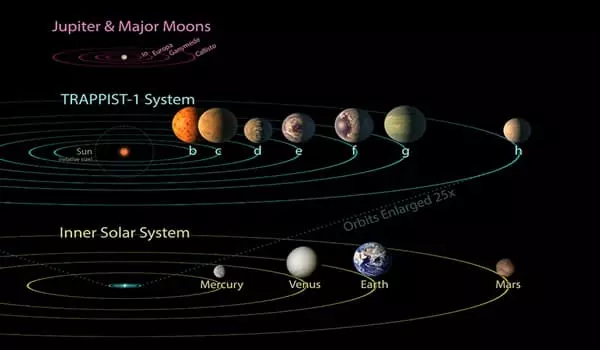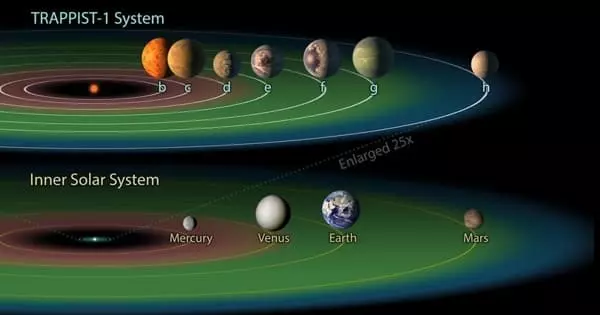Seven Earth-sized planets orbit the star TRAPPIST-1 in near-perfect harmony, and researchers from the United States and Europe have used that harmony to calculate how much physical abuse the planets could have endured in their infancy.
“After rocky planets form, things bash into them,” said Sean Raymond, an astrophysicist at the University of Bordeaux in France. “It’s known as bombardment or late accretion, and we care about it because these impacts can provide an important source of water and volatile elements that support life.”
Raymond and colleagues from Rice University’s NASA-funded CLEVER Planets project and seven other institutions used a computer model of TRAPPIST-1’s bombardment phase of planetary formation to explore the impacts its planets could have withstood without being knocked out of harmony in a study published today in Nature Astronomy.
Deciphering the impact history of planets is difficult in our solar system and may appear hopeless in systems light-years away, according to Raymond. “On Earth, we can measure specific elements and compare them to meteorites,” Raymond explained. “We do that to try to figure out how much stuff smashed into the Earth after it was mostly formed.”
These tools, however, do not exist for studying bombardment on exoplanets.
“They’ll never give us rocks,” he predicted. “They’ll never have craters on them. So, what are our options? This is where TRAPPIST-1’s unique orbital configuration comes into play. It’s a kind of lever we can use to put a stop to this.”
We discovered that after these planets formed, they were only bombarded by a very small amount of stuff. It’s useful information to have when considering other aspects of the planets in the system.
Professor Raymond
TRAPPIST-1, located approximately 40 light-years away, is much smaller and cooler than our sun. Its planets are named alphabetically in order of their distance from the star, from b to h. One orbit around the star, which is equivalent to one year on Earth, takes 1.5 days on planet b and 19 days on planet h. Surprisingly, their orbital periods form near-perfect ratios, resembling a harmonious musical arrangement. For every eight “years” on planet b, five pass on planet c, three on planet d, two on planet e, and so on.
“We can’t say how much stuff was thrown into any of these planets, but we can put an upper limit on it because of this special resonant configuration,” Raymond explained. “We can say, ‘It couldn’t be more than this.'” And it turns out that the upper limit is quite small.
“We discovered that after these planets formed, they were only bombarded by a very small amount of stuff,” he explained. “That’s pretty cool. It’s useful information to have when considering other aspects of the planets in the system.”
Planets form in protoplanetary disks of gas and dust that form around newly formed stars. These disks only last a few million years, and previous research has shown that resonant chains of planets like TRAPPIST-1 form when young planets migrate closer to their star before the disk disappears, according to Raymond. Computer simulations have shown that disks can guide planets into resonance. Raymond believes that resonant chains, such as TRAPPIST-1’s, must be set before their disks vanish.
According to Rice study co-author and CLEVER Planets postdoctoral fellow Andre Izidoro, TRAPPIST-1’s planets formed quickly, in about one-tenth the time it took Earth to form.

CLEVER Planets, led by study co-author Rajdeep Dasgupta, the Maurice Ewing Professor of Earth Systems Science at Rice, is investigating how planets might acquire the elements required for life. Dasgupta and colleagues at CLEVER Planets have previously demonstrated that a significant portion of Earth’s volatile elements came from the impact that formed the moon.
“If a planet forms too early and is too small, like the moon or Mars, it cannot absorb a lot of gas from the disk,” Dasgupta explained. “Such a planet also has a much lower chance of acquiring life-essential volatile elements through late bombardments.”
That, according to Izidoro, would have been the case for Earth, which gained the majority of its mass relatively late, including about 1% from impacts after the moon-forming collision. “We know Earth had at least one massive impact after the gas (in the protoplanetary disk) was gone,” he explained. “That was the event that resulted in the formation of the moon.”
“We have these Earth-mass planets that formed early in the TRAPPIST-1 system,” he explained. “So one possible difference between their formation and that of the Earth is that they could have had some hydrogen atmosphere from the start and never experienced a late giant impact. And this could change a lot of the evolution of the planet’s interior, out-gassing, volatile loss, and other things with implications for habitability.”
This week’s study, according to Raymond, has implications not only for the study of other resonant planetary systems, but also for far more common exoplanet systems that were thought to have started as resonant systems.
“Super-Earths and sub-Neptunes are very abundant around other stars, and the dominant theory is that they migrated inward during that gas-disk phase and then possibly collided late,” Raymond explained. “However, we believe that during that early phase, when they were migrating inward, they had a phase where they were resonant chain structures like TRAPPIST-1. They simply did not survive. They eventually became unstable.”
One of the study’s major contributions, according to Izidoro, could come years from now, when NASA’s James Webb Space Telescope, the European Southern Observatory’s Extremely Large Telescope, and other instruments enable astronomers to directly observe exoplanet atmospheres.
“We have some constraints today on the composition of these planets, such as how much water they can have,” Izidoro said of planets formed during a resonant, migration phase. “However, we have very large error bars.”
Observations will improve our understanding of the interior composition of exoplanets in the future, and knowing the late bombardment history of resonant planets could be extremely useful. “For example, if one of these planets has a lot of water, say a 20% mass fraction, the water must have been incorporated into the planets early, during the gaseous phase,” he explained. “So you’ll have to figure out what kind of process brought this water to this planet.”





